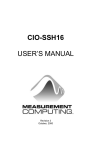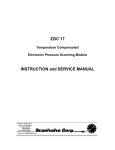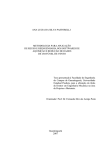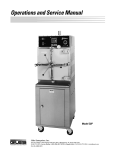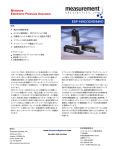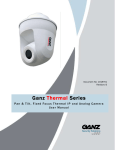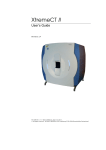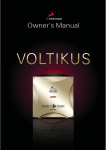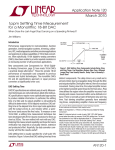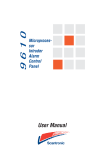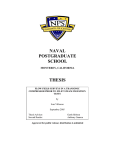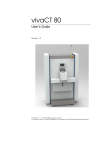Download ZOC 33/64Px and ZOC 33/64PxX2
Transcript
ZOC 33/64Px and ZOC 33/64PxX2 Electronic Pressure Scanning Module Instruction and Service Manual Preface Section 1: Introduction ZOC33 PREFACE Warnings, Cautions and Notes The WARNING! symbol indicates that danger of injury for persons and the environment and/or considerable damage (mortal danger, danger of injury) will occur if the respective safety precautions are not taken. The CAUTION ! symbol indicate danger for the system and material if the respective safety precautions are not taken. The ESD note symbol indicates that proper precautions for handling Electrostatic Sensitive Devices needs to be taken when performing the related operation. This includes the use of grounded work surfaces and personal wrist straps to prevent damage to sensitive electronic components. Warranty not to be defective, shall be at the expense of Buyer or the end user, whichever has returned such product or component part. Scanivalve Corporation, Liberty Lake, Washington, hereafter referred to as Seller, warrants to the Buyer and the first end user that its products will be free from defects in workmanship and material for a period of twelve (12) months from date of delivery. Written notice of any claimed defect must be received by Seller within thirty (30) days after such defect is first discovered. The claimed defective product must be returned by prepaid transportation to Seller within ninety (90) days after the defect is first discovered. Seller’s obligations under this Warranty are limited to repairing or replacing, at its option, any product or component part thereof that is proven to be other than as herein warranted. This Warranty does not extend to any Seller product or component part thereof which has been subjected to misuse, accident or improper installation, maintenance or application; or to any product or component part thereof which has been repaired or altered outside of Seller’s facilities unless authorized in writing by Seller, or unless such installation, repair or alteration is performed by Seller; or to any labor charges whatsoever, whether for removal and/ or reinstallation of the defective product or component part or otherwise, except for Seller’s labor charges for repair or replacement in accordance with the Warranty. Any repaired or replacement product or component part thereof provided by Seller under this Warranty shall, upon redelivery to Buyer, be warranted for the unexpired portion of the original product warranty. Surface transportation charges covering any repaired or replacement product or component part shall be at Seller’s expense; however, inspection, testing and return transportation charges covering any product or component part returned and redelivered, which proves THIS WARRANTY IS IN LIEU OF AND EXCLUDES ALL OTHER WARRANTIES, EXPRESS OR IMPLIED, ARISING BY iv Section 1: Introduction Preface ZOC33 Contact Information OPERATION OF LAW OR OTHERWISE, INCLUDING THE IMPLIED WARRANTIES OF MERCHANTABILITY AND FITNESS FOR A PARTICULAR PURPOSE, AND IN NO EVENT SHALL SELLER BE LIABLE FOR INCIDENTAL OR CONSEQUENTIAL DAMAGES. If there are any questions or concerns regarding any Scanivalve product please do not hesitate to contact us at the following: Scanivalve Corp. 1722 N. Madson Street Liberty Lake, WA 99019 Telephone: (800)935-5151 (509)891-9970 Fax: (509)891-9481 [email protected] www.scanivalve.com In the event of a failure: 1) Notify Scanivalve Corporation, Customer Service Department. Include model number and serial number. On receipt of this information, service data or shipping instructions will be forwarded. This may be transacted by telephone or e-mail. 2) On receipt of shipping instructions, forward the product, transportation prepaid. Repairs will be made and the product returned. 3) All shipments should be made via “Best Way”. The product should be shipped in the original packing container or wrapped in protective material and surrounded by a minimum of four (4) inches of a shock absorbing material. Scanivalve Corporation is an ISO9001:2000 certified company. Trademarks ® and Copyrights © Scanivalve is a registered trademark of Scanivalve Corporation. All other brand and product names are trademarks or registered trademarks of their respective companies. Packaging for Shipment If the product must be shipped, whether being returned to Scanivalve or relocated to another location it must be packaged properly to minimize the risk of damage. The recommended method of packing is to place the instrument in a container, surrounded on all sides with at lease four inches of shock attenuating material such as Styrofoam peanuts. Important Notice Please note that the product specifications and other information contained in this manual are subject to change without notice. Scanivalve Corporation makes an effort and strives to provide complete and current information for the proper use of the equipment. If there are any questions regarding this manual or the proper use of the equipment, contact Scanivalve Corporation. v Table of Contents ZOC33 Table of Contents PREFACE iv Warnings, Cautions and Notes iv Warrantyiv Trademarks ® and Copyrights © v Packaging for Shipment v Important Notice v Contact Information v Section 1: Specifications 2 General Specifications Environment Specifications 2 2 Section 2: Introduction 4 General Description ZOC33/64Px ZOC33/64PxX2 ZOC33/64Px - Valveless Thermal Control Unit (ZOCTCU) 4 5 6 8 9 Section 3: Installation & Operation 10 Unpacking 10 Overview10 Electrical Inputs & Outputs 10 Pneumatic Inputs 11 Calibration Valve Operation 12 ZOC33 ZOCTCU Connectors 13 Sensor Installation 14 Section 4: Electronic Components 15 Amplifier Board Multiplexer Board Decoder Board 15 16 17 1 Section 1: Specifications ZOC33 Section 1: Specifications General Specifications Resolution infinite Size (WxHxD) 1.43” x 1.69” x 4.98” (36.42cm x 42.8cm x 126.37cm) Inputs (Px) 64 or 128 (PxX2) Pneumatic Connectors ZOC Px ZOC Control Pressures ZOCTCU .042” tubulations 0.063” tubulations 1-2 73 port connectors (73ZOCM-063) Electrical Connectors ZOC Module ZOCTCU 15 pin MDM 15SL2P MS3100A Type, Size 20 Power Requirements ZOC33 Module ZOCTCU +15Vdc @ 120mA -15Vdc @ 30mA +24VDC @ 1.0A Full Scale Output Standard Optional ±2.5Vdc ±5.0Vdc Weight ZOC33/64Px 11 oz (312g) ZOC33/64PxX2 13 oz (369g) ZOC33TCU 4.0 lbs (1.8kg) (including ZOC33 module) Full Scale Ranges ±10 inH2O, ±20 inH2O, 1psid, 2.5psid, 5psid, 15psid and 50psid (2.5kPa, 5kPa, 7kPa, 17kPa, 35kPa, 100kPa, and 350kPa) Accuracy (after calibration) 10 inH2O 20 inH2O 1psid 2.5psid 5psid 15psid 50psid ±0.15% FS ±0.12% FS ±0.10% FS ±0.10% FS ±0.08% FS ±0.08% FS ±0.08% FS Overpressure (No damage) 10 inH2O 20 inH2O 1psid 2.5psid 5psid 15psid 50psid Sensor Excitation +5Vdc Constant Voltage (Internally Supplied) Environment Specifications 5psi 5psi 5psi 200% 200% 200% 200% Operating Temperature Humidity Operation Storage Temperature Sensitivity RangeZeroSpan 10 inH2O 0.25% 0.10% 20 inH2O 0.25% 0.08% 1psid 0.10% 0.05% 2.5psid 0.10% 0.05% 5psid 0.10% 0.05% 15psid 0.10% 0.05% 50psid 0.10% 0.05% Max Reference Pressure 50 psig (350kPa) Scan Rate 40kHz (standalone) 0 to 60 °C 5 to 95% RH, Non-Condensing 5 to 95% RH, Non-Condensing Shock & Vibration Shock Vibration MIL-STD-810D Curve H 10G 10G Acceleration 10G Media Gasses compatible with Silicon, Silicone, Aluminum and Buna-N 2 Section Section1:1:Specifications Introduction Figure 1.1 - ZOC33/64PxX2 Dimensions [inches(mm)] ZOC33 3 Section 2: Introduction ZOC33 Section 2: Introduction General Description The ZOC33 is an electronic pressure scanner which can accept up to 128 pneumatic inputs. Each ZOC33 module incorporates 64 individual piezoresistive pressure sensors. Each eight pressure sensors are manufactured in a housing designed to facilitate field replacement. No special tools are required to access the sensors. The ZOC33 electronic pressure scanning module is specifically designed for use in wind tunnels, flight tests or applications where space is at a premium and pressures will not exceed 50 psi. The ZOC33 is powered by ±15Vdc. The module is manufactured in a 64 channel model, a 128 channel duplexed model and a 64 channel valveless model. All models are available in multiplexed versions only. The ZOC33 pressure sensors are arranged in blocks of 8. In all variations except the valveless model, each block of eight sensors has its own individual calibration valve. This valve had four modes of operations: (1) (2) (3) (4) Operate Calibrate Purge Isolate The modes are selected by applying control pressures in a predetermined and logical order. The ZOC33 calibration valves utilizes valve logic where the valve defaults to the purge mode when no control pressures are applied. Beginning with serial number 144, all ZOC33 modules have a 500 ohm platinum RTD installed. This RTD is used by a DSM3000/3200/3400 module or RAD3200/4000 module to determine the temperature of the ZOC33 module. This feature will be added to any older ZOC33 module received for repairs. Beginning with serial number 390, all ZOC33 modules have a TEDS ID chip installed and programmed to interface with a RAD3200/4000 or DSM3400 pressure measuring system. This feature will be added to all older ZOC33 modules received for repair. Beginning with serial number 399, the ZOC33 valves were redesigned. This results in a small change to the module dimensions. This change only applies to valved models. A ZOC33 valved model that requires repairs to the valves will have to be upgraded to the newest configuration. 4 Section 2: Introduction ZOC33 ZOC33/64Px This module contains sixty four (64) pressure sensors in eight sensor packs. Each sensor pack contains: • • • • eight sensors a calibration valve an excitation board a high speed multiplexer The output of each sensor is directed to the multiplexer/ amplifier. The channel to be output is selected by a CMOS level binary address supplied by either a Scanivalve data acquisition system or by the customer’s data acquisition system. Figure 2.1 depicts a ZOC33/64Px. Figure 2.1 - ZOC33/64Px Dimensions [inches(cm)] 5 Section 2: Introduction ZOC33 ZOC33/64PxX2 Figure 2.2 depicts a ZOC33/64PxX2, Serial number 398 and earlier. Figure 2.3 depicts a ZOC33/64PxX2, Serial number 399 and later. This module contains sixty four (64) pressure sensors in eight sensor packs. Each sensor pack contains: • • • • • • eight sensors a calibration valve a duplexing valve an excitation board a high speed multiplexer 16 input tubes (Bank A and Bank B, 8 inputs each) The sensors are arranged in eight groups of eight. Each sensor has two pneumatic inputs: Bank A and Bank B. The inputs are switched pneumatically by enabling the duplexing valve. Even though there are 128 pressure inputs only one Bank of 64 pressure inputs can be measured at one time. Each group of eight sensors may be a different range. The standard output of the module is ±2.5Vdc corresponding to the channel selected by a CMOS level 6 bit binary address. Figure 2.2 - Early ZOC33/64PxX2 Dimensions [inches(cm)] 6 Section 2: Introduction ZOC33 Figure 2.3 - Current ZOC33/64PxX2 Dimensions [inches(mm)] 7 Section 2: Introduction ZOC33 ZOC33/64Px - Valveless This version does not have a calibration valve. All calibrations are performed using the reference port. In wind tunnel applications, a zero offset correction is performed “wind off.” The valveless design is also preferred for rotating applications as no control pressures are required. This module contains sixty four (64) pressure sensors in eight sensor packs. Each sensor pack contains: • • • eight sensors an excitation board a high speed multiplexer Figure 2.4 depicts a ZOC33/64Px Valveless. The output of each sensor is directed to the multiplexer/ amplifier. The channel to be output is selected by a CMOS level binary address supplied by either a Scanivalve data acquisition system or by the customer’s data acquisition system. Figure 2.4 - ZOC33/64Px Valveless Dimensions [inches(cm)] 8 Section 2: Introduction ZOC33 Thermal Control Unit (ZOCTCU) An optional Thermal Control Unit (ZOCTCU) (Figure 2.5) is available for applications where temperature swings my be great enough to exceed the compensated range of the sensors. Exceeding the compensated temperature range can induce errors in the pressure measurements. See Section 1, Specifications for more information on the compensated temperature range. The ZOCTCU consists of a housing, insulation and a proportional heater which will maintain the temperature for the module at 40°C ±0.3°C. Figure 2.5 - ZOC33 Thermal Control Unit (128 channel shown) 9 Section 3: Installation & Operation ZOC33 Section 3: Installation & Operation all other ZOC cable serviced modules. The ZOC33 may be installed into existing HyScan systems without changing configurations. Unpacking All ZOC33 modules have been extensively tested prior to shipment. All modules are packed to minimize the chances of shipping damage. However, damage can still occur. The customer must inspect the modules and shipping materials for obvious signs of damage. If it is suspected that damage may have occurred, contact Scanivalve Corporation immediately. The user is cautioned to follow safe instrument handling practices when handling the ZOC33 modules. This includes: (1) Make and break all connections to the module with the power off. (2) Recommended power input to the module is ±15Vdc. Figure 3.2 shows the output connector pin assignments for all of the ZOC33 variations. This figure shows the RTD connections (+Tem and -Temp) and the TEDS ID chip output (ID). These connections may not be active on all modules. Refer to Section 2, Introduction for more information. Once you have unpacked the module, do an inventory check of the shipment. Each shipment should at least include a mating connector and this manual. Overview ZOC33 modules are designed to function best when used with one of Scanivalve Corporation’s data acquisition systems, either a DSM3000/3200/3400 or RAD3200/4000. All ZOC33 modules will function with older data acquisition systems such as HyScan 2000/1000 as well. They can also be used as a standalone module with another high speed data acquisition system. CAUTION! Not following standard safe instrumentation handling practices could permanently damage the modules. Electrical Inputs & Outputs The Electrical Input and Output wiring is compatible with Figure 3.1 - ZOC33/64Px Exploded View 10 Section 3: Installation & Operation ZOC33 Manifold blocks are provided with the module to facilitate plumbing. This also permits easy removal of a sensor pack in the event that field repairs are required. Figure 3.2 - ZOC33 Input/Output Connector Pneumatic Inputs Figure 3.3 - ZOC33/64Px Pneumatic Inputs Pneumatic inputs consist of: Px Inputs(8 or 16), Control Pressure Inputs ( PxA Ctl, Cal Ctl), a Calibration Input, and a Reference Input. The duplex version also has a duplex control pressure input (PxB). Valveless units do not have Control Pressure and Calibration Inputs All Px inputs are .040 inch(1.067mm) bulged tubulations. These tubulations are designed to accept any .042 inch tubing manufactured by Scanivalve Corp. Each sensor pack valve block contains eight (8) or, in the duplex version, sixteen(16) Px inputs. ZOC33 modules are capable of measuring pressures up to 50 psid. Control pressure inputs consist of: PxA CTL and CAL CTL. The duplex module has a third control pressure input, PxB CTL. These inputs are used to switch the valve logic to each of the four (4) states: Operate, Calibrate, Purge, and Isolate. The control pressures must be 65 psi. Figure 3.3 shows the 64Px valve logic. Figure 3.4 shows the 64PxX2 Valve Logic. Calibration/Reference Inputs consist of a Calibration input and a Reference input. The Calibration input is an .042 inch O.D. tubulation. It is normally connected to a source of calibration pressures. Internally, this input is manifolded to all of the sensors through the calibration valving. The Reference input is an .063 inch (1.6mm)O.D. tubulation. It provides a point of reference for the transducers. All of the sensors in each block of eight share a single reference. Figure 3.4 - ZOC33/64PxX2 Pneumatic Inputs 11 Section 3: Installation & Operation ZOC33 Purge Mode This mode connects the Px inputs to the pressure sensors and the calibration input. A safe purge pressure can be applied to purge input lines. Isolate Mode This mode isolates the pressure sensors from the Px and calibration lines. Tables 3.1, 3.2 and 3.3 are state tables that describe pneumatic logic for each state of the valves. Table 3.1 - ZOC33/64Px Valve Logic Figure 3.5 - ZOC33/64Px Valveless Pneumatic Inputs Mode Px CTL CAL CTL Operate X 65psi Calibrate 65psi X Purge X X Isolate 65psi 65psi Table 3.2 - ZOC33/64PxX2 Valve Logic Mode PxA CTL PxB CTL CAL CTL Operate A X 65psi 65psi Operate B 65psi X 65psi Calibrate 65psi 65psi X Purge X X X Isolate 65psi 65psi 65psi Figure 3.6 - ZOC33 Channel Identification Table 3.3 - ZOC33/64Px Valveless Valve Logic Calibration Valve Operation As discussed in Section 2, Introduction, ZOC33/64Px and ZOC33/64PxX2 modules are equipped with an internal calibration valve in each sensor pack. The calibration valve can take one of four states: Mode Px CTL CAL CTL Operate X X Calibrate N/A N/A Purge N/A N/A Isolate N/A N/A NOTE: Valveless Modules do not have control pressure inputs It is important that all control pressures should be dry, filtered instrument air or nitrogen. Operate Mode This connects each Px input to its associated pressure sensor. The ZOC33/64PxX2 module allows the customer to select one of two banks for input. Calibrate Mode This mode connects all the pressure sensors to the calibration input. 12 Section 3: Installation & Operation ZOC33 ZOC33 ZOCTCU Connectors Table 3.4 - ZOCTCU Pneumatic Inputs Figure 3.7 shows the pneumatic and electrical connectors on a ZOC33 ZOCTCU. View B shows the electrical connector, View A shows the pneumatic connector for inputs 1-64, control pressures, the reference input and the calibration inputs. View C shows the pneumatic inputs for channels 65-128. This connector is not installed on a non-duplexed module. The drawing has been modified from the actual configuration for clarity. Channels Connector Tubes 1-64 View A 1-64 PxA CTL View A PxA CTL Notes PxB is not connected in a nonduplexed module PxB CTL View A PxB CTL CAL CTL View A CAL CTL CAL HI View A CAL HI CAL LOW View A CAL LOW REF HI View A REF HI REF LOW View A REF LOW 1-64 View C This connector is only installed for duplex modules 1-64 Table 3.5 - ZOCTCU Electrical Inputs/Outputs Pin Figure 3.7 - ZOC33 ZOCTCU Connectors 13 Function Notes A Address 0 B Address 1 C Address 2 D Address 3 E Address 4 F +15Vdc G -15Vdc H + Temp ZOC33 Internal RTD J - Temp ZOC33 Internal RTD K ±15Vdc Return L + Output M - Output P + Temp (Heater) Heater Temperature - Pre March 2000 only R ID TEDS Chip information S Address 5 T - Temp (Heater) Heater Temperature - Pre March 2000 only U +28Vdc Heater Power V +28Vdc Return ±2.5Vdc Nominal Section 3: Installation & Operation ZOC33 Sensor Installation To replace a sensor, follow this procedure: The sensors used in a ZOC33 module are piezoresistive. They are a standard Scanivalve Corporation “S-sensor”. They are mounted in chip carriers which are then installed in 8-channel sensor packs. The sensor packs are field replaceable with standard hand tools. Replacing a sensor in the field is possible but not recommended without prior training from Scanivalve. If a sensor must be replaced, follow these instructions. (1) Remove appropriate sensor pack assembly from the ZOC33 (screws for each sensor pack are located at the base of the module). (2) If necessary, remove the valve from the sensor housing. This should be done only if tubing restrictions do not allow the sensor pack to be pulled. CAUTION! ESD PROTECTION REQUIRED. The proper use of grounded work surfaces and personal wrist straps are required when coming into contact with exposed circuits to prevent static discharge from damaging sensitive electronic components. (3) Remove the sensor screw access plate. DO NOT REMOVE O-RINGS. (4) Remove the PC board. (5) Loosen the sensor hold down screw. DO NOT REMOVE THE SCREW OR O-RING. (6) Carefully remove the damaged sensor. Take care not to damage the wire bonds. CAUTION! Failing to carefully follow this procedure could permanently damage the modules. Figure 3.8 - ZOC33 Sensor Pack Exploded View 14 Section 4: Electronic Components ZOC33 Section 4: Electronic Components Amplifier Board The amplifier board receives an millivolt input from the channel selected by the multiplexer. The signal is amplified to a nominal 2.5 Vdc full scale and output through the decoder board to the I/O connector. The amplifier gain is set by selecting R1 to match the average output of the sensors. The amplifier (INA110) has a settling time of 20 microseconds which means that the module channels can be scanned at 40 kHz in a “stand-alone” configuration. Gain and zero adjustments are provided to permit the user to better match the ZOC33 to a non-HyScan system (Figure 4.1). This circuit also receives an input from an RTD mounted on the Decoder Board. The RTD circuit provides a feedback to the amplifier that increases the gain by approximately 0.2%/°C. This will compensate for the 0.2%/°C decrease in output inherent in pieziorestive sensors. Figure 4.1 - Zero and Span adjustments CAUTION! Adjusting the Zero and Span adjustments will invalidate any current calibration coefficients for the module. Figure 4.2 - ZOC33 Amplifier Board Schematic 15 Section 4: Electronic Components ZOC33 Multiplexer Board The multiplexer receives millivolt input signals from each of the sensors. It also receives inputs from the decoder board which select the channel to be output to the amplifier board. The multiplexer is a DG507. It has a settling time of 400 nanoseconds. Each eight (8) channel sensor pack has its own combination multiplexer and excitation board. The board consists of a precision voltage regulator, eight sensor mounts, and a multiplexer. The board is installed on the sensor housing (Figure 3.8). The board is powered by ±15Vdc. This voltage must be regulated, but does not need to be “instrumentation quality”. The precision voltage regulator is an LT1021 which converts the ±15Vdc to a precision 5.00Vdc. The LT1021 has a very tight output voltage tolerance and a very low temperature coefficient. The output of the LT1021 is used as an excitation voltage for the sensors. The Multiplexer board plugs into the decoder board. Figure 4.3 - ZOC33 Multiplexer Board Schematic 16 Section 4: Electronic Components ZOC33 Decoder Board The data system outputs an address for a channel to be read. The address is sensed by the decoder board and converted to an address and enable output. The enable line selects the sensor pack and the address line selects the channel in that pack. The signal output of that sensor is then input to the amplifier board, amplified and routed back through the decoder board to the I/O connector. The decoder board is the main circuit board in the ZOC33. All of the sensor packs and the amplifier plug into this board. The decoder board receives the inputs from the data system and converts them into signals to drive the sensor packs. Address lines A0 through A5 are routed from the I/O connector to two 4042 latches which convert the address input to a 3 bit channel address and a one of eight enable. A channel in the module is selected by the following: Figure 4.4 - ZOC33 Decoder Board Schematic 17 Section 4: Electronic Components ZOC33 Figure 4.5 - ZOC33 Decoder Board Connector Pinouts 18 Section 4: Electronic Components Figure 4.6 - ZOC33 Decoder Board Layout ZOC33 19 ZOC33 1722 N. Madson St. Liberty Lake, WA 99019 Phone: 1-800-935-5151 1-509-891-9970 Fax: 1-509-891-9481 [email protected] www.scanivalve.com ZOC33 Service Manual July, 2010 21























